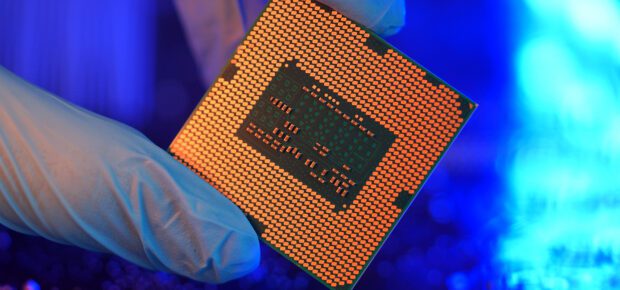October 11, 2024
Semiconductors play an increasingly crucial role in our daily lives — they power the cars we drive, sustain the businesses that fuel our economy and enable global communication. As our reliance on these components grows, ensuring that they function reliably and securely becomes ever more important. Recent outages and disruptions have shown how vital secure, reliable devices and seamless connectivity are in today’s interconnected world.
The Need for Security Assurance
The COVID-19 pandemic highlighted the critical importance of global supply chain resilience. When certain components became unavailable, the resulting disruptions rippled throughout the entire supply chain, causing delays that sometimes took years to recover from. This underscored the complexity and interdependence involved in creating a computer chip, which demands robust security measures at every stage of its design and production. The need for security spans the entire chip lifecycle, from design and manufacturing to packaging, test, and even to the chip’s end of life.
At the forefront of this lifecycle is chip design. A computer chip consists of numerous licensable, reusable components known as intellectual property (IP) blocks, which can come from various sources, including internal teams, external vendors, IP suppliers, and even tools. These IP blocks are integrated into the chip but can present security risks if not properly evaluated. To address this challenge, the IEEE Standards Association (IEEE SA) has established a working group, P3164, to focus on Security Annotation for Electronic Design Integration (SA-EDI).
IEEE P3164: Enhancing Chip Design Security
The P3164 working group aims to tackle security concerns by developing a methodology and database to assess the security risks associated with each IP block. This will allow integration teams to review and identify security risks during the design phase of the chip lifecycle. Identified risks can be addressed by swapping out high-risk IP, mitigating the risk associated with the IP or accepting the risk when necessary.
The group’s methodology involves a formal process for identifying potential attack points within an IP block that could be exploited. This enables designers to pinpoint associated security risks and develop strategies to manage them effectively. Additionally, a knowledge base of known vulnerabilities related to specific IP blocks will further assist in assessing security risks. As new vulnerabilities are discovered, users can contribute to this database, ensuring that it remains up-to-date and comprehensive.
Expanding Security Beyond IP Blocks
In addition to securing IP blocks and the physical components of chips, the semiconductor industry is increasingly focused on cryptography and secure protocols. With advancements in algorithms related to quantum computing, traditional cryptographic methods are becoming vulnerable, creating a need for more robust security measures. This shift has far-reaching implications, from securing user login information to safeguarding data storage and transfers, and protecting secure keys that control digital access.
In response to these challenges, the industry is investing in cutting-edge innovations in cybersecurity. These efforts include advanced security access layers, the development of future-proof cryptographic algorithms, and the preparation of a workforce skilled in both the semiconductor ecosystem and security challenges across the entire lifecycle. As the need for enhanced security grows, so too does the necessity for an informed, adaptable workforce capable of meeting the demands of this evolving landscape.
Strengthening Security in a Connected World
The semiconductor industry’s growing role in our lives necessitates an equally strong focus on security, especially as supply chains become more complex and interconnected. By establishing formal methodologies for assessing and mitigating security risks at the design stage, technical initiatives like the IEEE P3164 working group are critical to ensuring the continued safety and reliability of semiconductors throughout their lifecycle. As the digital landscape evolves, the semiconductor industry must stay vigilant, continuously advancing security measures to address emerging threats and ensure the resilience of the technologies that shape our future. Through continued collaboration and innovation, we can protect the technologies that power our digital world.
ABOUT OUR AUTHOR
Kathy Hayashi is an IEEE Senior Member and member of IEEE HKN. She is the Chair of the Global Semiconductors Group of IEEE Future Directions and a senior consultant in semiconductor workflows.






 Meaningful Momentum or Running in Place?
Meaningful Momentum or Running in Place? AI Through Our Ages
AI Through Our Ages Liquid Infrastructure: Our Planet's Most Precious Resource
Liquid Infrastructure: Our Planet's Most Precious Resource The Impact of Technology in 2025
The Impact of Technology in 2025 Quantum and AI: Safeguards or Threats to Cybersecurity?
Quantum and AI: Safeguards or Threats to Cybersecurity? Why AI Can't Live Without Us
Why AI Can't Live Without Us Bits, Bytes, Buildings and Bridges: Digital-Driven Infrastructure
Bits, Bytes, Buildings and Bridges: Digital-Driven Infrastructure Impact of Technology in 2024
Impact of Technology in 2024 Emerging AI Cybersecurity Challenges and Solutions
Emerging AI Cybersecurity Challenges and Solutions The Skies are Unlimited
The Skies are Unlimited Smart Cities 2030: How Tech is Reshaping Urbanscapes
Smart Cities 2030: How Tech is Reshaping Urbanscapes Impact of Technology 2023
Impact of Technology 2023 Cybersecurity for Life-Changing Innovations
Cybersecurity for Life-Changing Innovations Smarter Wearables Healthier Life
Smarter Wearables Healthier Life Infrastructure In Motion
Infrastructure In Motion The Impact of Tech in 2022 and Beyond
The Impact of Tech in 2022 and Beyond Cybersecurity, Technology and Protecting Our World
Cybersecurity, Technology and Protecting Our World How Technology Helps us Understand Our Health and Wellness
How Technology Helps us Understand Our Health and Wellness The Resilience of Humanity
The Resilience of Humanity Harnessing and Sustaining our Natural Resources
Harnessing and Sustaining our Natural Resources Creating Healthy Spaces Through Technology
Creating Healthy Spaces Through Technology Exceptional Infrastructure Challenges, Technology and Humanity
Exceptional Infrastructure Challenges, Technology and Humanity The Global Impact of IEEE's 802 Standards
The Global Impact of IEEE's 802 Standards Scenes of our Cyber Lives: The Security Threats and Technology Solutions Protecting Us
Scenes of our Cyber Lives: The Security Threats and Technology Solutions Protecting Us How Millennial Parents are Embracing Health and Wellness Technologies for Their Generation Alpha Kids
How Millennial Parents are Embracing Health and Wellness Technologies for Their Generation Alpha Kids Space Exploration, Technology and Our Lives
Space Exploration, Technology and Our Lives Global Innovation and the Environment
Global Innovation and the Environment How Technology, Privacy and Security are Changing Each Other (And Us)
How Technology, Privacy and Security are Changing Each Other (And Us) Find us in booth 31506, LVCC South Hall 3 and experience the Technology Moon Walk
Find us in booth 31506, LVCC South Hall 3 and experience the Technology Moon Walk Virtual and Mixed Reality
Virtual and Mixed Reality How Robots are Improving our Health
How Robots are Improving our Health IEEE Experts and the Robots They are Teaching
IEEE Experts and the Robots They are Teaching See how millennial parents around the world see AI impacting the lives of their tech-infused offspring
See how millennial parents around the world see AI impacting the lives of their tech-infused offspring Take the journey from farm to table and learn how IoT will help us reach the rising demand for food production
Take the journey from farm to table and learn how IoT will help us reach the rising demand for food production Watch technical experts discuss the latest cyber threats
Watch technical experts discuss the latest cyber threats Explore how researchers, teachers, explorers, healthcare and medical professionals use immersive technologies
Explore how researchers, teachers, explorers, healthcare and medical professionals use immersive technologies Follow the timeline to see how Generation AI will be impacted by technology
Follow the timeline to see how Generation AI will be impacted by technology Learn how your IoT data can be used by experiencing a day in a connected life
Learn how your IoT data can be used by experiencing a day in a connected life Listen to technical experts discuss the biggest security threats today
Listen to technical experts discuss the biggest security threats today See how tech has influenced and evolved with the Games
See how tech has influenced and evolved with the Games Enter our virtual home to explore the IoT (Internet of Things) technologies
Enter our virtual home to explore the IoT (Internet of Things) technologies Explore an interactive map showcasing exciting innovations in robotics
Explore an interactive map showcasing exciting innovations in robotics Interactively explore A.I. in recent Hollywood movies
Interactively explore A.I. in recent Hollywood movies Get immersed in technologies that will improve patients' lives
Get immersed in technologies that will improve patients' lives